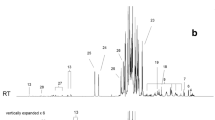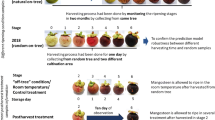Abstract
Introduction
The shelf-life of fresh-cut lettuce after storage is limited by several factors that affect its quality and lead to consumer rejection. Different metabolic events occur after cutting as an abiotic stress response.
Objectives
This study aims to explore the metabolome of iceberg lettuce and to understand the changes related to storage time and genetics applying an untargeted metabolomics approach.
Methods
Two cultivars with different browning susceptibility, fast-browning (FB) and slow-browning (SB), were analyzed by UPLC-ESI-QTOF-MS just after cutting (d0) and after five days of storage (d5). Extraction, metabolic profiling, and data-pretreatment procedures were optimized to obtain a robust and reliable data set.
Results
Preliminary principal component analysis and hierarchical cluster analysis of the full dataset [around 8551 extracted, aligned and filtered molecular features (MFs)] showed a clear separation between the different samples (FB-d0, FB-d5, SB-d0, and SB-d5), highlighting a clear storage time-dependent effect. After statistical analysis applying Student’s t test, 536 MFs were detected as significantly different between d0 and d5 of storage in FB and 633 in SB. Some of them (221) were common to both cultivars. Out of these significant compounds, 22 were tentatively identified by matching their molecular formulae with those previously reported in the literature. Five families of metabolites were detected: amino acids, phenolic compounds, sesquiterpene lactones, fatty acids, and lysophospholipids. All compounds showed a clear trend to decrease at d5 except phenolic compounds that increased after storage.
Conclusion
The untargeted metabolomics analysis is a powerful tool for characterizing the changes on lettuce metabolome associated with cultivar and especially with storage time. Some families of compounds affected by storage time were reported to be closely related to quality loss.





Similar content being viewed by others
References
Abu-Reidah, I. M., Contreras, M. M., Arraez-Roman, D., Segura-Carretero, A., & Fernandez-Gutierrez, A. (2013). Reversed-phase ultra-high-performance liquid chromatography coupled to electrospray ionization-quadrupole-time-of-flight mass spectrometry as a powerful tool for metabolic profiling of vegetables: Lactuca sativa as an example of its application. Journal of Chromatography A, 1313, 212–227.
Arapitsas, P., Speri, G., Angeli, A., Perenzoni, D., & Mattivi, F. (2014). The influence of storage on the “chemical age” of red wines. Metabolomics, 10(5), 816–832.
Beni, C., Marconi, S., Boccia, P., Ciampa, A., Diana, G., Aromolo, R., et al. (2011). Use of arsenic contaminated irrigation water for lettuce cropping: effects on soil, groundwater, and vegetal. Biological Trace Element Research, 143(1), 518–529.
Bernillon, S., Biais, B., Deborde, C., Maucourt, M., Cabasson, C., Gibon, Y., et al. (2013). Metabolomic and elemental profiling of melon fruit quality as affected by genotype and environment. Metabolomics, 9(1), 57–77.
De Vos, R. C. H., Moco, S., Lommen, A., Keurentjes, J. J. B., Bino, R. J., & Hall, R. D. (2007). Untargeted large-scale plant metabolomics using liquid chromatography coupled to mass spectrometry. Nature Protocols, 2(4), 778–791.
Diaz, R., Pozo, O. J., Sancho, J. V., & Hernandez, F. (2014). Metabolomic approaches for orange origin discrimination by ultra-high performance liquid chromatography coupled to quadrupole time-of-flight mass spectrometry. Food Chemistry, 157, 84–93.
Farneti, B., Busatto, N., Khomenko, I., Cappellin, L., Gutierrez, S., Spinelli, F., et al. (2015). Untargeted metabolomics investigation of volatile compounds involved in the development of apple superficial scald by PTR-ToF-MS. Metabolomics, 11(2), 341–349.
Ferri, E., Galimberti, A., Casiraghi, M., Airoldi, C., Ciaramelli, C., Palmioli, A., et al. (2015). Towards a universal approach based on omics technologies for the quality control of food. BioMed Research International, 365794, 1–14.
Fiehn, O. (2001). Combining genomics, metabolome analysis, and biochemical modeling to understand metabolic networks. Comparative and Functional Genomics, 2(3), 155–168.
Garcia-Cañas, V., Simo, C., Herrero, M., Ibanez, E., & Cifuentes, A. (2012). Present and future challenges in food analysis: foodomics. Analytical Chemistry, 84(23), 10150–10159.
Gil, M. I., Tudela, J. A., Martínez-Sánchez, A., & Luna, M. C. (2012). Harvest maturity indicators of leafy vegetables. Stewart Postharvest Review, 8(1), 1–9.
Heimler, D., Isolani, L., Vignolini, P., Tombelli, S., & Romani, A. (2007). Polyphenol content and antioxidative activity in some species of freshly consumed salads. Journal of Agricultural and Food Chemistry, 55(5), 1724–1729.
Hendriks, M., van Eeuwijk, F. A., Jellema, R. H., Westerhuis, J. A., Reijmers, T. H., Hoefsloot, H. C. J., et al. (2011). Data-processing strategies for metabolomics studies. Trac-Trends in Analytical Chemistry, 30(10), 1685–1698.
Jaiswal, R., Kiprotich, J., & Kuhnert, N. (2011). Determination of the hydroxycinnamate profile of 12 members of the Asteraceae family. Phytochemistry, 72(8), 781–790.
Le Boucher, C., Courant, F., Royer, A. L., Jeanson, S., Lortal, S., Dervilly-Pinel, G., et al. (2015). LC-HRMS fingerprinting as an efficient approach to highlight fine differences in cheese metabolome during ripening. Metabolomics, 11(5), 1117–1130.
Llorach, R., Martinez-Sanchez, A., Tomas-Barberan, F. A., Gil, M. I., & Ferreres, F. (2008). Characterisation of polyphenols and antioxidant properties of five lettuce varieties and escarole. Food Chemistry, 108(3), 1028–1038.
Lopez-Galvez, G., Saltveit, M., & Cantwell, M. (1996). Wound-induced phenylalanine ammonia lyase activity: factors affecting its induction and correlation with the quality of minimally processed lettuces. Postharvest Biology and Technology, 9(2), 223–233.
Lopez-Sanchez, P., de Vos, R. C. H., Jonker, H. H., Mumm, R., Hall, R. D., Bialek, L., et al. (2015). Comprehensive metabolomics to evaluate the impact of industrial processing on the phytochemical composition of vegetables purees. Food Chemistry, 168, 348–355.
Lucini, L., Rouphael, Y., Cardarelli, M., Canaguier, R., Kumar, P., & Colla, G. (2015). The effect of a plant-derived biostimulant on metabolic profiling and crop performance of lettuce grown under saline conditions. Scientia Horticulturae, 182, 124–133.
Luna, M. C., Tudela, J. A., Martinez-Sanchez, A., Allende, A., Marin, A., & Gil, M. I. (2012). Long-term deficit and excess of irrigation influences quality and browning related enzymes and phenolic metabolism of fresh-cut iceberg lettuce (Lactuca sativa L.). Postharvest Biology and Technology, 73, 37–45.
Mai, F., & Glomb, M. A. (2014). Isolation of phenolic compounds from iceberg lettuce and impact on enzymatic browning. Journal of Agricultural and Food Chemistry, 61(11), 2868–2874.
Martinez-Sanchez, A., Luna, M. C., Selma, M. V., Tudela, J. A., Abad, J., & Gil, M. I. (2012). Baby-leaf and multi-leaf of green and red lettuces are suitable raw materials for the fresh-cut industry. Postharvest Biology and Technology, 63(1), 1–10.
Martinez-Sanchez, A., Tudela, J. A., Luna, C., Allende, A., & Gil, M. I. (2011). Low oxygen levels and light exposure affect quality of fresh-cut Romaine lettuce. Postharvest Biology and Technology, 59(1), 34–42.
Martin-Lorenzo, M., Zubiri, I., Maroto, A. S., Gonzalez-Calero, L., Posada-Ayala, M., de la Cuesta, F., et al. (2015). KLK1 and ZG16B proteins and arginine-proline metabolism identified as novel targets to monitor atherosclerosis, acute coronary syndrome, and recovery. Metabolomics, 11(5), 1056–1106.
Monti, L. L., Bustamante, C. A., Osorio, S., Gabilondo, J., Borsani, J., Lauxmann, M. A., et al. (2016). Metabolic profiling of a range of peach fruit varieties reveals high metabolic diversity and commonalities and differences during ripening. Food Chemistry, 190, 879–888.
Neumann, S., & Boecker, S. (2010). Computational mass spectrometry for metabolomics: identification of metabolites and small molecules. Analytical and Bioanalytical Chemistry, 398(7–8), 2779–2788.
O’Hagan, S., Swainston, N., Handl, J., & Kell, D. B. (2015). A ‘rule of 0.5′ for the metabolite-likeness of approved pharmaceutical drugs. Metabolomics, 11(2), 323–339.
Pereira, S. I., Figueiredo, P. I., Barros, A. S., Dias, M. C., Santos, C., Duarte, I. F., et al. (2014). Changes in the metabolome of lettuce leaves due to exposure to mancozeb pesticide. Food Chemistry, 154, 291–298.
Puchades-Carrasco, L., & Pineda-Lucena, A. (2015). Metabolomics in pharmaceutical research and development. Current Opinion in Biotechnology, 35, 73–77.
Ribas-Agusti, A., Gratacos-Cubarsi, M., Sarraga, C., Garcia-Regueiro, J. A., & Castellari, M. (2011). Analysis of eleven phenolic compounds including novel p-coumaroyl derivatives in lettuce (Lactuca sativa L.) by ultra-high-performance liquid chromatography with photodiode array and mass spectrometry detection. Phytochemical Analysis, 22(6), 555–563.
Roessner, U., Luedemann, A., Brust, D., Fiehn, O., Linke, T., Willmitzer, L., et al. (2001). Metabolic profiling allows comprehensive phenotyping of genetically or environmentally modified plant systems. Plant Cell, 13(1), 11–29.
Saltveit, M. E., Choi, Y. J., & Tomas-Barberan, F. A. (2005). Involvement of components of the phospholipid-signaling pathway in wound-induced phenylpropanoid metabolism in lettuce (Lactuca sativa) leaf tissue. Physiologia Plantarum, 125(3), 345–355.
Sanchez-Perez, E. M., Jose-Iglesias, M., Lopez-Ortiz, F., Sanchez-Perez, I., & Martinez-Galera, M. (2010). Study of the suitability of HRMAS NMR for metabolic profiling of tomatoes: application to tissue differentiation and fruit ripening. Food Chemistry, 122(3), 877–887.
Scherer, G. F. E. (1996). Phospholipid signaling and lipid-derived second messengers in plants. Plant Growth Regulation, 18(1–2), 125–133.
Schilling, C. H., Schuster, S., Palsson, B. O., & Heinrich, R. (1999). Metabolic pathway analysis: basic concepts and scientific applications in the post-genomic era. Biotechnology Progress, 15(3), 296–303.
Sessa, R. A., Bennett, M. H., Lewis, M. J., Mansfield, J. W., & Beale, M. H. (2000). Metabolite profiling of sesquiterpene lactones from Lactuca species: major latex components are novel oxalate and sulfate conjugates of lactucin and its derivatives. Journal of Biological Chemistry, 275(35), 26877–26884.
Shepherd, L. V. T., Fraser, P., & Steward, D. (2011). Metabolomics: a second-generation platform for crop and food analysis. Bioanalysis, 3, 1143–1159.
Sobolev, A. P., Brosio, E., Gianferri, R., & Segre, A. L. (2005). Metabolic profile of lettuce leaves by high-field NMR spectra. Magnetic Resonance in Chemistry, 43(8), 625–638.
Sobolev, A. P., Capitani, D., Giannino, D., Nicolodi, C., Testone, G., Santoro, F., et al. (2010). NMR-metabolic methodology in the study of GM foods. Nutrients, 2(1), 1–15.
Sugimoto, M., Goto, H., Otomo, K., Ito, M., Onuma, H., Suzuki, A., et al. (2010). Metabolomic profiles and sensory attributes of edamame under various storage duration and temperature conditions. Journal of Agricultural and Food Chemistry, 58(14), 8418–8425.
Sumner, L. W., Amberg, A., Barrett, D., Beale, M. H., Beger, R., Daykin, C. A., et al. (2007). Proposed minimum reporting standards for chemical analysis. Metabolomics, 3, 211–221.
Toivonen, P. M. A., & Brummell, D. A. (2008). Biochemical basis of appearance and texture changes in fresh-cut fruit and vegetables. Postharvest Biology and Technology, 48(1), 1–14.
Tomas-Barberan, F. A., LoaizaVelarde, J., Bonfanti, A., & Saltveit, M. E. (1997). Early wound- and ethylene-induced changes in phenylpropanoid metabolism in harvested lettuce. Journal of the American Society for Horticultural Science, 122(3), 399–404.
Weckwerth, W. (2010). Metabolomics: an integral technique in systems biology. Bioanalysis, 2(4), 829–836.
Wesolowska, A., Nikiforuk, A., Michalska, K., Kisiel, W., & Chojnacka-Wojcik, E. (2006). Analgesic and sedative activities of lactucin and some lactucin-like guaianolides in mice. Journal of Ethnopharmacology, 107(2), 254–258.
Yan, X. J., Li, H. Y., Xu, J. L., & Zhou, C. X. (2010). Analysis of phospholipids in microalga Nitzschia closterium by UPLC-Q-TOF-MS. Chinese Journal of Oceanology and Limnology, 28(1), 106–112.
Acknowledgments
Authors thank the MINECO (project AGL2013-48529-R) and Fundación Séneca (19900/GERM/15) for financial support. Carlos García-Hernández benefitted from a grant (BES-2014-069233). Authors are also grateful to Natalia Hernández for the assistance with lettuce processing (preparation and extraction of samples) and Fernando Álvarez for the graphic design.
Author information
Authors and Affiliations
Corresponding author
Ethics declarations
Conflict of interest
The authors declare that they have no conflict of interest.
Ethical approval
This study does not involve the use of animal or human samples.
Electronic supplementary material
Below is the link to the electronic supplementary material.
Rights and permissions
About this article
Cite this article
Garcia, C.J., García-Villalba, R., Garrido, Y. et al. Untargeted metabolomics approach using UPLC-ESI-QTOF-MS to explore the metabolome of fresh-cut iceberg lettuce. Metabolomics 12, 138 (2016). https://doi.org/10.1007/s11306-016-1082-x
Received:
Accepted:
Published:
DOI: https://doi.org/10.1007/s11306-016-1082-x




